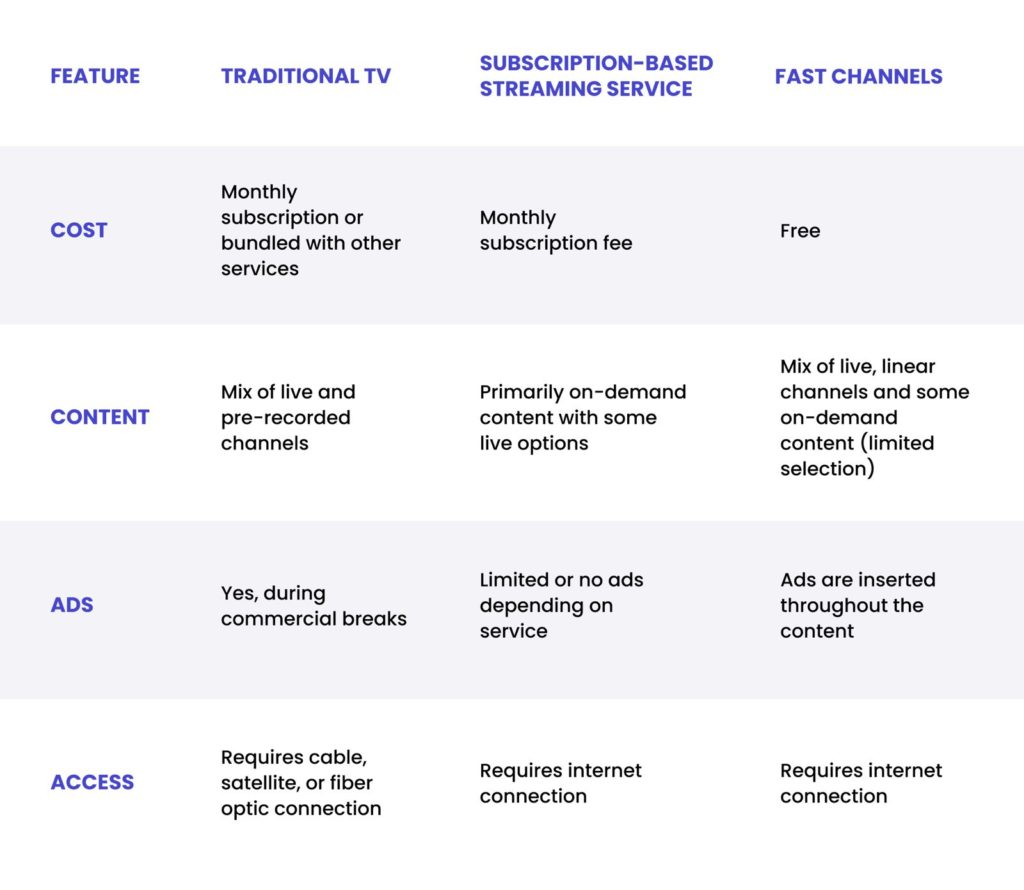Will FAST channels replace subscription streaming services?
FAST channels are an emerging type of streaming service that is rapidly gaining popularity. They provide a wide range of content, such as movies, TV shows, and sports, and are increasingly utilised by businesses and individuals seeking a convenient way to access content on the move. In this article, we will examine the rising trend of FAST channels, explore their influence on the traditional subscription-based streaming model, and assess whether they present a significant challenge to established platforms.
Overview of FAST channels
FAST (Free Ad-Supported Streaming Television) channels are fast becoming a significant segment in the streaming media industry. Unlike traditional cable or satellite TV, FAST channels deliver content over the internet without subscription fees. Instead, they rely on advertising revenue, just like conventional TV, allowing viewers to access a wide range of programmes for free. This includes live TV, on-demand content, films, series, news, and niche programmes.
The growing popularity of FAST channels can be attributed to several factors. The convenience of streaming content to smart TVs and streaming devices has made it readily available. Major industry players have embraced the FAST model, offering extensive content libraries and a seamless viewing experience. In addition, the shift to more affordable entertainment options has increased demand for FAST channels. Research shows that nearly half of US households regularly use FAST, indicating its growing appeal.
Comparison with traditional and subscription streaming services
Below is a breakdown of how FAST channels stack up against traditional and subscription-based streaming services:

As highlighted above, FAST channels offer a free and flexible alternative to traditional and subscription-based television services. By blending the features of live TV with the ease and convenience of internet streaming, FAST channels appeal to a broad audience seeking affordable entertainment options.
Rapid growth and rising popularity of FAST channels
The popularity and expansion of FAST channels has accelerated significantly in recent years, driven by evolving consumer behaviour, advances in technology, and growing demand for affordable entertainment options. According to a recent report, there are now more than 1,900 individual FAST channels in the US alone, a staggering 214% growth since 2020.
Several key factors are driving this rapid growth in the FAST market:
- More and more consumers are ditching costly cable subscriptions in favour of more flexible streaming services, which is contributing to the rapid growth in the popularity of FAST channels.
- In times of economic uncertainty or financial constraints, the availability of free content via FAST channels becomes particularly attractive to consumers who want to reduce their entertainment costs.
- Improvements in internet infrastructure, combined with the widespread availability of smart TVs, streaming devices, and mobile technology, have made it easier for viewers to access FAST channels anywhere, anytime.
- FAST channels offer a wide range of content, including classic TV shows, movies, news, sports, and niche programmes. This diversity attracts a wide audience, catering to different tastes and preferences.
Advantages of FAST channels
Free access and reduced subscription fatigue
One of the key advantages of FAST channels is that they provide viewers with free access to a diverse array of content. This model is particularly beneficial today when many consumers are experiencing ‘subscription fatigue’ – a growing sense of overwhelm due to the increasing number of paid streaming services required to access all desired content.
Ad-supported revenue models
The ad-supported revenue model is a crucial component of the success and sustainability of FAST channels.
Revenue generation: By relying on advertisements for revenue, FAST channels can offer high-quality content at no cost to viewers while maintaining a steady income stream. This revenue allows for continuous investment in content acquisition and platform enhancements.
Lower financial barriers: The ad-supported model removes financial barriers for viewers, making content accessible to a broader and more diverse audience.
Effective ad placements: FAST channels can utilise viewer data to deliver more targeted and relevant advertisements, enhancing both ad effectiveness and viewer satisfaction. This targeted advertising often leads to higher engagement rates and better returns for advertisers.
Viewer tolerance: Many viewers are open to watching ads in exchange for free content, especially when the ad load is manageable, and the ads are tailored to their interests.
Advantages for consumers and advertisers
FAST channels provide unique benefits for both consumers and advertisers, creating a symbiotic ecosystem that benefits both parties.
Benefits for consumers
- Free entertainment: Consumers can access a wide variety of content without any cost, making entertainment accessible to everyone, regardless of income.
- Diverse content: With a mix of live TV and on-demand options, viewers can enjoy scheduled programming alongside flexible viewing choices, catering to different preferences and habits.
- Convenience: FAST channels are accessible across multiple devices, allowing consumers to watch their favourite shows and movies anytime, anywhere. The absence of contracts or long-term commitments further enhances the convenience and appeal.
Benefits for advertisers
- Broad reach: FAST channels draw a diverse audience, allowing advertisers to connect with a wide and varied demographic. This extensive reach is particularly valuable for brands seeking to boost visibility and market presence.
- Enhanced targeting: Leveraging advanced analytics and audience data, advertisers can deliver ads more precisely, ensuring that their messages reach the most relevant viewers. This targeted approach enhances the effectiveness of ad campaigns and maximises ROI.
- Engaged audiences: Since viewers willingly watch ads in exchange for free content, they are generally more receptive to advertisements. This increased engagement can lead to better ad recall and improved overall campaign performance.
Challenges and limitations of FAST channels
Despite their increasing popularity, FAST channels face several challenges and limitations.
One significant challenge is their heavy reliance on advertising revenue. While ads make it possible to offer free content, frequent interruptions can disrupt the viewing experience and lead to viewer dissatisfaction. Additionally, the effectiveness of ads can vary, with repetitive or irrelevant advertisements potentially annoying viewers. This dependence on advertising also means that revenue can be volatile, subject to fluctuations in the advertising market, which may impact the financial stability of FAST channel providers.
Another limitation lies in the variety and quality of content. Although FAST channels provide a mix of live and on-demand options, their content libraries are often smaller and may not match the quality of those offered by subscription-based streaming services.
User experience and technology also pose challenges for FAST channels. Compared to subscription services, FAST may offer less advanced user interfaces, fewer personalised features, and less sophisticated recommendation algorithms. These factors can negatively impact the overall user experience, making it more difficult for viewers to discover new content or enjoy a seamless viewing experience.
Lastly, competition and market saturation are growing concerns. As more companies enter the FAST market, the competition for both viewers and advertisers become more intense.
The verdict
FAST channels and subscription streaming services serve distinct audience segments, each offering unique advantages. FAST channels appeal to budget-conscious viewers by providing free content supported by ads, while subscription services attract those who prefer an ad-free experience and access to exclusive programming.
Subscription services often invest significantly in high-quality, original content, building loyal customer bases. They also offer advanced features like offline viewing, multiple user profiles, and high-definition streaming, which enhance the overall user experience. Many viewers are willing to pay for an uninterrupted viewing experience, and hybrid models, which offer both ad-supported and ad-free tiers, successfully capture a broad audience.
In conclusion, FAST channels are unlikely to replace subscription streaming services. Instead, both will continue to coexist, offering complementary viewing options and catering to diverse consumer preferences.
At Spyrosoft, we are dedicated to helping media companies optimise their operations and stay ahead in a competitive industry. Whether you are managing FAST channels or a subscription-based service, our expertise can help you streamline processes, improve user experience, and ensure your platform stands out.
Book a meeting with us for more detailed insights and solutions tailored to your needs.
About the author
Get in touch

